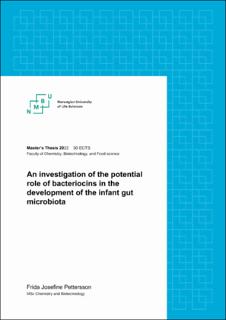| dc.contributor.advisor | Rudi, Knut | |
| dc.contributor.advisor | Ormaasen, Ida | |
| dc.contributor.author | Pettersson, Frida Josefine | |
| dc.date.accessioned | 2022-09-28T08:34:21Z | |
| dc.date.available | 2022-09-28T08:34:21Z | |
| dc.date.issued | 2022 | |
| dc.identifier.uri | https://hdl.handle.net/11250/3022057 | |
| dc.description.abstract | The colonization of the infant gut microbiota is important for health and wellbeing later in life. This colonization is dependent on multiple factors, among others the competition between bacteria. Different strategies have been developed to gain an advantage over the other bacteria in the competition for space and nutrition. One such strategy is to synthesize bacteriocins, which are small ribosomally produced peptides that can inhibit the growth of or kill the competing bacteria. The genus Streptococcus is a known bacteriocin producer and an important part of the infant gut microbiota. This genus is among the early colonizers of the gut and has been found to dominate this microbiota during the first few days of the infant’s life. Since little is known about the role of bacteriocins in the development of the infant gut microbiota, the main aim of this thesis was to investigate the associations between bacteriocins and Streptococcus in stool samples.
Seven bacteriocins were chosen for this study based on their significant presence in the gut of infants compared to adults and they were synthesized in vitro before their ability to inhibit bacteria belonging to the genera Streptococcus, Enterococcus, Listeria, and Lactococctus was investigated. In addition, qPCR with designed primers was used to identify bacteriocin genes and 16S rRNA sequencing to identify the bacteria present in stool samples provided by the PreventADALL study. A total of 168 stool samples were studied, where 56 samples belonged to each of the three groups: infants at 6 months, infants at 12 months, and mothers.
In conclusion, Sanger sequencing and microscopy confirmed that the cultivation of the streptococcal bacteria was successful. The two bacteriocin activity assays showed that none of the bacteriocins inhibited the growth of the tested bacteria. This could most likely be caused by an unsuccessful bacteriocin synthesis or a classification error of the bacteriocins. The genus Streptococcus was significantly enriched in samples from infants compared to mothers, as expected from previous studies. The only significant association between the presence of bacteriocins and the number of streptococcal reads was found in samples from infants at 12 months of age. Where the presence of bacteriocins gave significantly more reads from the streptococcal OTU nr.2, but this association was not identified in samples from infants at 6 months of age or mothers. More associations could possibly be identified in samples taken from an earlier timepoint in the infant’s life, and this should be considered in further studies. | en_US |
| dc.description.abstract | Koloniseringen av spedbarns tarmfloraen er viktig for helse og velvære senere i livet. Denne koloniseringen er avhengig av flere faktorer, blant annet konkurransen mellom bakterier. Ulike strategier er utviklet for å få en fordel i denne konkurransen om næring og plass. En strategi går ut på å produsere bakteriosiner som er små ribosomalt produserte peptider. Disse peptidene kan hemme veksten av eller drepe andre bakterier. Slekten Streptococcus er en kjent bakteriosin produsent og utgjør en viktig del av tarmfloraen til spedbarn. Denne slekten er blant de tidlige kolonisatorene og dominerer tarmmikrobiotaen de første dagene av spedbarnets liv. Lite er fortsatt kjent om rollen til bakteriosiner i utvikling av tarmfloraen og hovedmålet til denne oppgaven var dermed å undersøke om det var noen sammenheng mellom bakteriosiner og streptokokker i fekal prøver.
Syv bakteriosiner ble valgt ut til denne studien basert på deres signifikante tilstedeværelse i tarmfloraen til spedbarn sammenlignet med tarmfloraen til voksne og de ble syntetisert in vitro før testing av deres evne til å hemme veksten av bakterier som tilhørte slektene Streptococcus, Enterococcus, Listeria og Lactococcus ble undersøkt. I tillegg ble qPCR brukt til å identifisere bakteriosin gener og 16S rRNA sekvensering til å identifisere bakterier til stede i fekal prøver fra PreventADALL studien. Totalt ble 168 prøver studert og 56 prøver tilhørte hver av de tre gruppene: spedbarn ved 6 måneder, spedbarn ved 12 måneder og mødre.
For å konkludere, Sanger sekvensering og mikroskopering bekreftet at dyrkingen av streptokokkene var en suksess. I de to testene for bakteriosin aktivitet kom det fram at veksten til de testede bakteriene ikke ble hemmet av bakteriosinene. Dette kunne mest sannsynlig skyldes feil i bakteriosinsyntesen eller en klassifiseringsfeil av bakteriosinene. Videre ble det funnet at slekten Streptococcus var signifikant anriket i de samlede prøvene fra spedbarna sammenlignet med prøvene fra mødrene. Den eneste signifikante sammenhengen mellom tilstedeværelse av bakteriosiner og streptokokker ble funnet i prøver tatt fra 12 måneder gamle barn. Her ble det funnet at streptokokk OTU nr.2 var signifikant anriket i prøver hvor det var bakteriosiner til stede, men dette var ikke tilfellet i prøver tatt fra 6 måneder gamle barn eller mor. Flere assosiasjoner kan muligens identifiseres i prøver tatt ved tidligere tidspunkt av barnets liv og dette bør derfor vurderes i videre studier. | en_US |
| dc.language.iso | eng | en_US |
| dc.publisher | Norwegian University of Life Sciences, Ås | en_US |
| dc.rights | Attribution-NonCommercial-NoDerivatives 4.0 Internasjonal | * |
| dc.rights.uri | http://creativecommons.org/licenses/by-nc-nd/4.0/deed.no | * |
| dc.title | An investigation of the potential role of bacteriocins in the development of the infant gut microbiota | en_US |
| dc.type | Master thesis | en_US |
| dc.description.localcode | M-KB | en_US |

